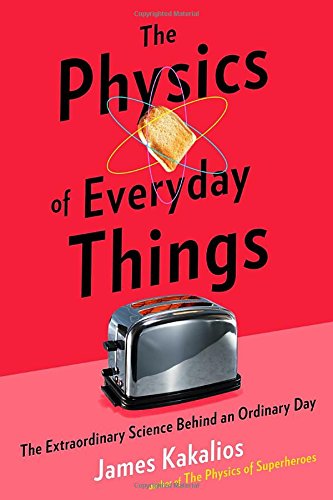
![]() The Physics of Everyday Things: The Extraordinary Science Behind an Ordinary Day by James Kakalios
The Physics of Everyday Things: The Extraordinary Science Behind an Ordinary Day by James Kakalios
James Kakalios structures his popular science book, The Physics of Everyday Things: The Extraordinary Science Behind an Ordinary Day (2017), around following a person through a typical day and stopping periodically to explain the science (particularly obviously, the physics) behind the technology the person uses and/or engages with, such as a hotel keycard, a toaster, an LED TV, a copier machine and so forth. Both the explanations and the structure succeed to a mixed degree, and while I found at the end the book to be informative and generally rewarding, its style and structure seemed to work against its task of popularizing science/tech for the masses.
The structure’s issues tend to be that following a person progressively through their day gives a sense of chronological order, but little else. In other words, not much is gained. On the flip side, what is lost is a sense of thematic or logical structure, meaning our dips into various technologies not only feel random but at times are also repetitive in nature, as two techs that the “you” of the book interacts with at different times might make use of the same basic scientific principles, and so we get an overlapping discussion, if not to the same depth or degree. Following a person through a day is a cute idea that one might think humanizes the topic, but it turns out better in concept than execution or effect.
A larger issue is that the science here can get pretty dense. At times he assumes probably a greater knowledge of basic terms and concepts than many readers (and probably most people in general) have. And even when he explains terms in easy-to-digest fashion, sometimes the explanation would have been better as prelude rather than epilogue to whatever topic is being discussion as sometimes is the case. I’m not a scientist, but regularly read popularizing science works, and I definitely had to work at The Physics of Everyday Things, rereading several passages multiple times to be sure I understood what he was getting at. Beyond some further breaking down of terms/concepts and simpler language, more illustrations would also have definitely helped (it’s possible my ARC copy simply lacked them and that the published version has more).
And the language can sometimes form a thicket of its own. Some of Kakalios’ metaphors work quite well (a theater metaphor in particular), but others, I’d say, fog things up more than they enlighten. And even when the prose is fluid and clear, I can’t say it’s ever particularly engaging.
Despite all these issues, and despite The Physics of Everyday Things feeling a bit betwixt and between (maybe too dense for those who know very little science and unnecessary for those who do), there’s not doubt that having put in some work, I came away better informed about how my day to day tech works. So it’s a net positive, but I wish it were more definitely so.



I like the idea of investigating the physics of common items/habits, but restricting it to a single day sounds like it would lead to repetition — as you point out. That’s a shame.